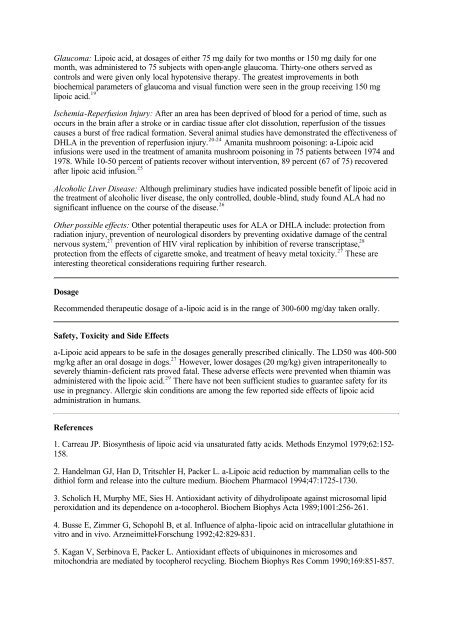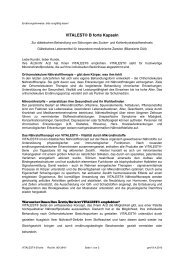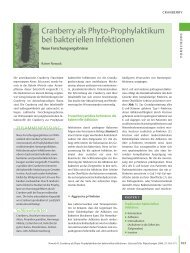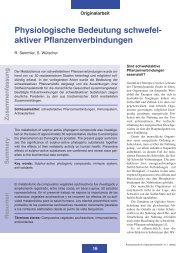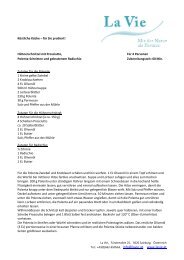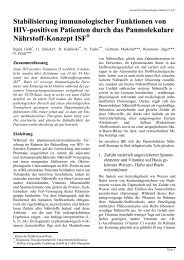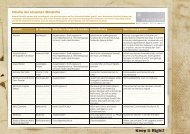Monograph - La Vie
Monograph - La Vie
Monograph - La Vie
You also want an ePaper? Increase the reach of your titles
YUMPU automatically turns print PDFs into web optimized ePapers that Google loves.
Glaucoma: Lipoic acid, at dosages of either 75 mg daily for two months or 150 mg daily for one<br />
month, was administered to 75 subjects with open-angle glaucoma. Thirty-one others served as<br />
controls and were given only local hypotensive therapy. The greatest improvements in both<br />
biochemical parameters of glaucoma and visual function were seen in the group receiving 150 mg<br />
lipoic acid. 19<br />
Ischemia-Reperfusion Injury: After an area has been deprived of blood for a period of time, such as<br />
occurs in the brain after a stroke or in cardiac tissue after clot dissolution, reperfusion of the tissues<br />
causes a burst of free radical formation. Several animal studies have demonstrated the effectiveness of<br />
DHLA in the prevention of reperfusion injury. 20-24 Amanita mushroom poisoning: a-Lipoic acid<br />
infusions were used in the treatment of amanita mushroom poisoning in 75 patients between 1974 and<br />
1978. While 10-50 percent of patients recover without intervention, 89 percent (67 of 75) recovered<br />
after lipoic acid infusion. 25<br />
Alcoholic Liver Disease: Although preliminary studies have indicated possible benefit of lipoic acid in<br />
the treatment of alcoholic liver disease, the only controlled, double -blind, study found ALA had no<br />
significant influence on the course of the disease. 26<br />
Other possible effects: Other potential therapeutic uses for ALA or DHLA include: protection from<br />
radiation injury, prevention of neurological disorders by preventing oxidative damage of the central<br />
nervous system, 27 prevention of HIV viral replication by inhibition of reverse transcriptase, 28<br />
protection from the effects of cigarette smoke, and treatment of heavy metal toxicity. 27 These are<br />
interesting theoretical considerations requiring further research.<br />
Dosage<br />
Recommended therapeutic dosage of a-lipoic acid is in the range of 300-600 mg/day taken orally.<br />
Safety, Toxicity and Side Effects<br />
a-Lipoic acid appears to be safe in the dosages generally prescribed clinically. The LD50 was 400-500<br />
mg/kg after an oral dosage in dogs. 27 However, lower dosages (20 mg/kg) given intraperitoneally to<br />
severely thiamin-deficient rats proved fatal. These adverse effects were prevented when thiamin was<br />
administered with the lipoic acid. 29 There have not been sufficient studies to guarantee safety for its<br />
use in pregnancy. Allergic skin conditions are among the few reported side effects of lipoic acid<br />
administration in humans.<br />
References<br />
1. Carreau JP. Biosynthesis of lipoic acid via unsaturated fatty acids. Methods Enzymol 1979;62:152-<br />
158.<br />
2. Handelman GJ, Han D, Tritschler H, Packer L. a-Lipoic acid reduction by mammalian cells to the<br />
dithiol form and release into the culture medium. Biochem Pharmacol 1994;47:1725-1730.<br />
3. Scholich H, Murphy ME, Sies H. Antioxidant activity of dihydrolipoate against microsomal lipid<br />
peroxidation and its dependence on a-tocopherol. Biochem Biophys Acta 1989;1001:256-261.<br />
4. Busse E, Zimmer G, Schopohl B, et al. Influence of alpha-lipoic acid on intracellular glutathione in<br />
vitro and in vivo. Arzneimittel-Forschung 1992;42:829-831.<br />
5. Kagan V, Serbinova E, Packer L. Antioxidant effects of ubiquinones in microsomes and<br />
mitochondria are mediated by tocopherol recycling. Biochem Biophys Res Comm 1990;169:851-857.


